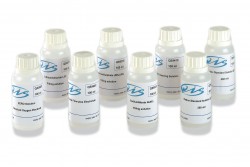Electrochemical measurements, including those taken using pH probes, Oxidation/Reduction Potential (ORP) probes, Ion Selective Electrodes (ISEs), and Electrolytic Conductance (EC) probes, primarily rely on potentiometry. In potentiometric measurements, the probe detects a potential in millivolts (mV), which can be directly reported as the measurement result (as with ORP), or used to calculate the final result through a calibration process (as with pH and ISE).
The mV reading in electrochemical measurements can be affected by several factors, with the reference system being particularly important. To address any variations in mV measurements due to differences in reference systems, the potential is often reported with respect to the Standard Hydrogen Electrode (SHE), which is the standard against which all other reference systems are compared. Even if all other variables are constant and two probes are reading identically to theoretical, an identical sample would give different mV readings on different probes with different reference systems. If the potential vs. SHE for two probes with different reference systems is known, the mV results can be compared on the same relative scale. Additionally, if the potential vs. SHE is known for a probe and the mV reading on a standard with SHE is also known, the probe's reading on that same standard can be easily calculated.
The mV reading in electrochemical measurements can be affected by several factors, with the reference system being particularly important. To address any variations in mV measurements due to differences in reference systems, the potential is often reported with respect to the Standard Hydrogen Electrode (SHE), which is the standard against which all other reference systems are compared. Even if all other variables are constant and two probes are reading identically to theoretical, an identical sample would give different mV readings on different probes with different reference systems. If the potential vs. SHE for two probes with different reference systems is known, the mV results can be compared on the same relative scale. Additionally, if the potential vs. SHE is known for a probe and the mV reading on a standard with SHE is also known, the probe's reading on that same standard can be easily calculated.

pH Storage Solution, 3M KCl, 500mL
QS942X
Redox Standard, +228mV (Ag/AgCl 4M KCl)(ZoBell's), 500mL
QS960X
Redox Standard, +124mV @25°C, 500mL (store dark)
QS960X-124
Redox Standard, +430mV @25°C, 500mL
QS960X-430

